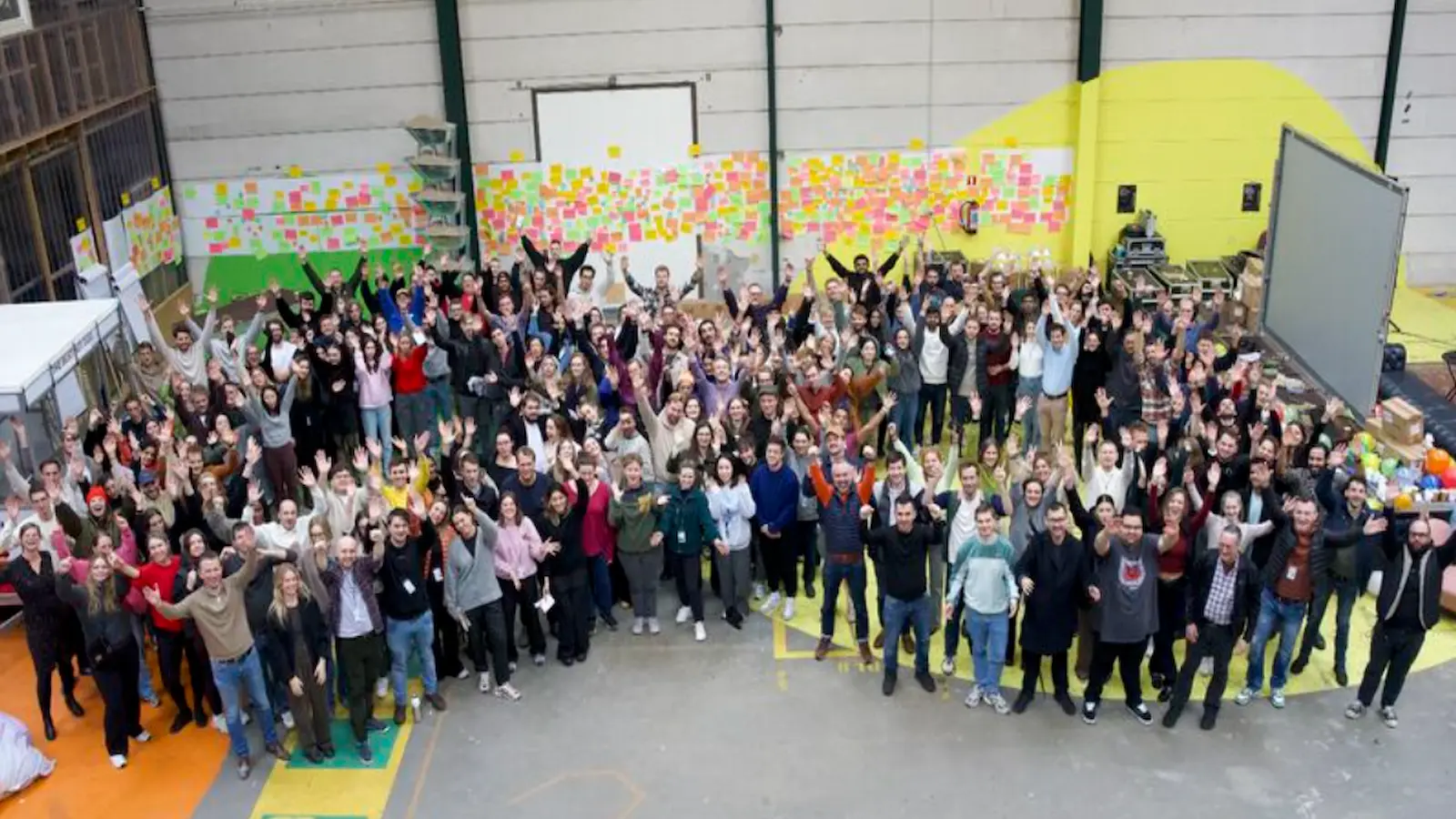Fairmarkit needed to foster a stronger feedback culture while scaling quickly. With Lattice, they introduced regular check-ins and performance reviews, empowering employees to grow and making managers more effective coaches.
“Lattice gives us a central hub where performance, development, engagement, and planning come together. It lets us operate strategically and speak the same language as our Finance partners.”

TL;DR: By aligning People and Finance under the CFO and using Lattice to power performance and growth, Fairmarkit helped increase its efficiency by 75% (as measured by ARR/FTE) and boosted engagement by 35% (as measured by eNPS). Learn how their strategic partnership has turned people programs into business drivers.
When Fairmarkit’s VP of People, Karishma Barua, reflects on what’s driven the procurement tech startup’s growth over the past few years, one theme rises to the top: alignment. Not just alignment between teams and goals, but between the People and Finance functions at the heart of Fairmarkit’s operating model.
“At a lot of companies, People and Finance only meet when they have to,” says Karishma. “At Fairmarkit, we operate as one team. From weekly hiring approvals to quarterly budget reviews, we’re constantly aligning our people strategy with financial goals.”
That tight partnership (supported by Lattice!) has transformed the way Fairmarkit plans, hires, develops, and enables its workforce. And the results speak for themselves: a 75% increase in annual reoccurring revenue (ARR) per full time employee (FTE), a 10% improvement in cost-to-hire and onboard, and a 35% boost in employee engagement.
This strategic alignment and measurable success also earned Karishma recognition as one of Lattice’s 2025 People Success Visionaries of the Year.
Here’s how they made it happen.
Building a Strategic Partnership Between People and Finance
When Karishma joined Fairmarkit as Director of People three years ago, the company was growing quickly and needed an operating model that could scale with it. One of the most defining choices came early: having the People and Finance teams both report to Fairmarkit CFO, Celeste Ackert.
That decision created more than reporting efficiency. It forged a strategic partnership rooted in shared goals, streamlined decision-making, and real business impact.
“Because we report into the same leader, we align early and often—on hiring plans, compensation strategy, budgeting, and more,” says Karishma. “It’s eliminated the back-and-forth that slows other teams down and helped us focus on what matters most.”
One of the first examples of that alignment in action was when Karishma and Celeste jointly made the call to move from quarterly to biannual performance reviews. While frequent reviews had allowed for continuous feedback, they came with a steep administrative cost and weren’t aligned with industry standards.
“With Lattice, we had the data to evaluate the impact of quarterly reviews and make a smooth transition to biannual,” Karishma explains. “Because Finance was involved from the beginning, it was a seamless shift that gave both teams back time for more strategic work.”
Turning People Strategy Into Business Strategy
At Fairmarkit, People isn’t seen as a siloed support function – it’s treated like a core business driver. That mindset shift has helped Karishma’s team tie their programs directly to company performance.
“We start with the business outcomes we’re trying to drive, then map our people strategy to support them,” she says. “Lattice gives us the infrastructure to make that connection clear.”
By integrating Lattice into their weekly and quarterly planning cadences, Karishma’s team can surface people metrics like engagement scores, performance trends, and development plan progress to help Finance and company leadership make more informed decisions.
“When we’re discussing budget or org design, we don’t just come with intuition – we come with data from Lattice that shows what’s working and where we need to invest,” Karishma says.
This strategic approach helped Fairmarkit refine their hiring priorities to focus on revenue-driving and product-delivery roles. It also allowed the People team to redesign onboarding, pairing in-person welcome days with structured ramp-up resources in Lattice, to help new hires become productive faster.
Supporting Managers with Structure and Tools
As Fairmarkit scaled, Karishma knew manager development would be critical to sustaining growth. “Managers have the biggest impact on employee experience,” she says. “So we made it a priority to standardize expectations and give them better tools and support.”
The company launched a manager enablement program, including workshops with their executive coach and internal trainings called Manager Matters. Lattice became the system that reinforced those lessons – providing visibility into 1:1s, feedback frequency, and development conversations.
“Lattice helped us build structure around how managers show up,” Karishma says. “We could track feedback quality, usage of development plans, and employee sentiment all in one place.”
The result was a more consistent and confident manager layer, with teams reporting higher engagement and more clarity around expectations and growth. Over time, Fairmarkit saw measurable improvements in manager effectiveness metrics and employee feedback across teams.
Embedding Growth with the FLY Framework
While manager development created consistency, employees were also looking for more clarity and direction in their own career growth. That’s when Karishma’s team launched Fairmarkit’s internal growth framework, Fairmarkit FLY, which stands for Foster Learning Year-round. Inspired by Fairmarkit’s flying eagle mascot, FLY empowers employees to take charge of their learning and growth. The framework is built on four pillars, known across the organization as the “4 E’s”: Experience, Exposure, Empower, and Education.
“We needed something lightweight, scalable, and flexible enough to meet people where they are,” says Karishma. “FLY gave us a shared language for growth.”
Lattice became the platform that powered FLY, from embedding it into growth plans and 1:1s to tracking progress through performance reviews.
“When we do performance reviews, we don’t just look at output—we also look at development against FLY goals,” Karishma says. “That dual lens has created more thoughtful goals and helped us make promotion decisions more holistically.”
Since launching FLY and embedding it into Lattice, Fairmarkit has seen a 35% increase in eNPS, stronger feedback quality, and higher participation in career conversations.
Why Lattice is Core to Fairmarkit’s Strategy
For Fairmarkit, Lattice is more than a people platform – it’s a system of alignment.
“Lattice gives us a central hub where performance, development, engagement, and planning come together,” says Karishma. “It lets us operate strategically and speak the same language as our Finance partners.”
Because the entire organization, from individual contributors to execs, engages with Lattice, the platform has become a living part of how Fairmarkit works. It’s where employee conversations happen, where growth plans live, and where company-wide development is measured.
“It’s not just a tool – it’s foundational to how we operate,” Karishma says. “And it’s one of the reasons we’ve been able to grow so efficiently while keeping people and performance at the center.”
Advice for Other People Leaders
Behind all of this is a deeper belief: that People is a business function, not a support function. And when you treat it that way, backed by data, trusted by Finance, and supported by the right tools, it becomes a true driver of growth.
Karishma’s advice for People teams looking to build stronger relationships with Finance is simple: start early, build trust, and speak the same language.
“Treat People like a business function,” she says. “That means bringing data to the table, aligning on metrics that matter, and showing how your programs drive outcomes.”
She also encourages teams not to wait until they hit friction to build the partnership. “Don’t wait until things are broken to build that partnership. If you invest in it now, you’ll see the return everywhere – from your engagement scores to your balance sheet. The earlier you align on hiring, compensation, and planning, the more strategic and proactive you can be.”
She credits much of the success to her partnership with Celeste and to a shared commitment to both employee experience and business outcomes. But she’s quick to point out that other teams can do this too.
“You don’t need a big People team or a huge budget,” she says. “You need the right focus, the right mindset, and a system that helps you operate strategically. For us, that’s Lattice.”
Fairmarkit’s story is proof that when People and Finance move in lockstep, and when that partnership is powered by a platform like Lattice, the impact is transformational. By embedding growth into everyday work, empowering managers, and aligning every people decision with business outcomes, Fairmarkit didn’t just improve efficiency, they unlocked outsized results: a 75% increase in key productivity metric they track ( ARR per FTE), and a 35% rise in engagement (as measured by eNPS).
For other People leaders looking to drive real business value, the takeaway is clear: don’t wait for alignment, build it. And with the right mindset and the right tools, you can turn your people strategy into your company’s biggest growth lever.
Key Takeaways
- People and Finance Alignment: Having both functions report to the CFO created a shared language and accelerated decision-making across workforce planning, budgeting, and strategic programs.
- Performance Management Streamlined with Lattice: Fairmarkit transitioned from quarterly to biannual reviews, utilizing insights from Lattice for team members to save time and focus on more strategic priorities.
- Manager Enablement at Scale: With tools like 1:1s and Feedback in Lattice, managers are now more consistent, confident, and aligned in how they support their teams.
- FLY Development Framework Embedded in Lattice: Fairmarkit’s growth framework is powered by Lattice, resulting in a 35% increase in engagement and more thoughtful development conversations.
- Business Outcomes Fueled by People Strategy: A 75% increase in employee productivity (ARR per FTE) and a 10% improvement in hiring/onboarding efficiency highlight the impact of aligning people programs with company goals.





%20(1).jpg)

